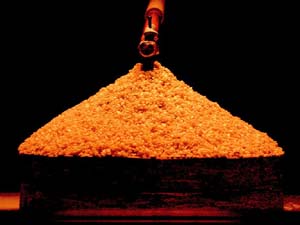| 2004 |

|
YEAR BOOK |
Lumen Christi College, Derry
|
Self-organised criticality in the dynamics of granular systems
(The great Sesame Street crash)
|

In this project, we examined the physics of sand piles as the stereotypical example of systems which produce structure from disorder without tuning. We showed that, while ideal computer sand pile models give rise to ideal critical behaviour, reasonable adaptations of these models which more closely represent reality exhibit enhanced numbers of large events due to the effect of finite system size. We reviewed experimental work on real sand and seed piles and note that the results are littered with examples of exactly this large event enhancement. We designed and constructed an apparatus in which a seed-pile is continually fed, sometimes for days, with a steady, tuneable supply of individual grains. We examined the distributions of events on these piles using a photographic technique which, we believe for the first time, allows the examination of small events on the surface of the pile. We showed that these events do indeed exhibit power law scaling indicative of SOC, but that their development is punctuated by large catastrophic collapses due to a fundamental change in causative mechanism. A qualitative model is developed for the occurrence of these events.
Breand�n Hill & Rois�n McCloskey entered their project in the Senior Group Section in the Chemical, Physical and Mathematical Sciences Category at the EsatBT Young Scientist & Technology Exhibition in January 2004. They won one of the top prizes The Best Group Award. They also won a Special Award sponsored by the Institute of Physics in Ireland. Their teacher was Ms Martina Gillen.
| This article was sponsored by The Institute of Physics |
|---|